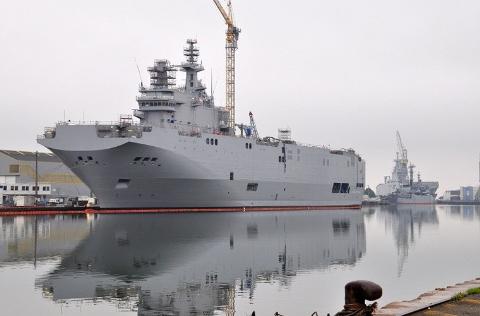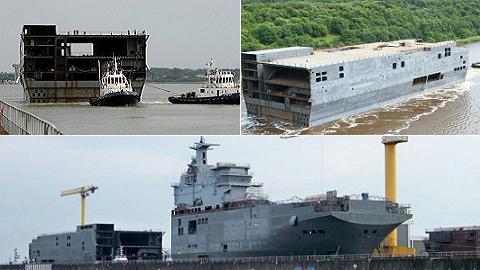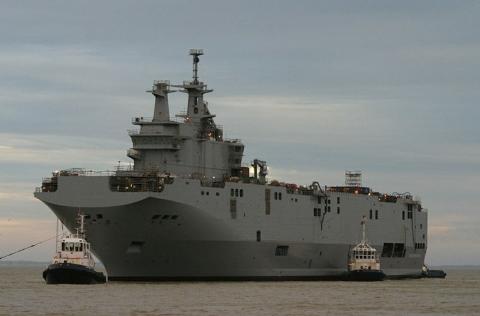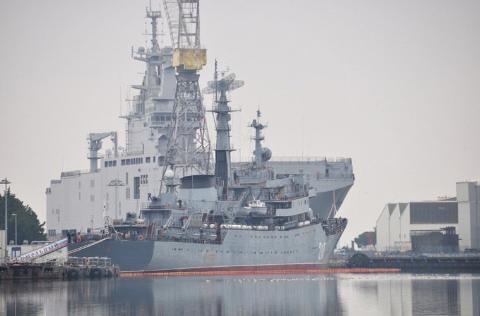If not handed over, Russia may turn Mistral into scrap metal
Russian Deputy Prime Minister Dmitry Rogozin once hinted that if France did not hand over the ships, Russia could turn the Mistral into scrap metal. So what is the truth of this story?
| RELATED NEWS |
|---|
Russia once declared that if France did not hand over, the Mistral would turn into scrap metal.
The complicated case surrounding the handover of the first French-built helicopter carrier to Russia, the Vladivostok, has not yet come to an end. On December 19, the French President continued to reaffirm that he would not hand over the Mistral-class landing ship, the Vladivostok, to Russia until the situation in Ukraine had positive changes.
It is known that Russia ordered France to build two Mistral-class helicopter landing ships in June 2011, worth 1.6 billion USD. According to the plan, the first ship named Vladivostok will be handed over to the Russian navy by the end of 2014, while the second ship, named Sevastopol, will be handed over in 2015.
However, the implementation of this contract is facing many risks after Western countries imposed sanctions on Russia due to its alleged involvement in the crisis in Ukraine and France has been hesitant to hand over the first ship to Russia.
The delivery of the Mistral-class warship is at the center of public opinion as France has delayed the delivery of the warship to Russia as stipulated in the contract this November, in response to the embargo and sanctions imposed by the US and EU on Russia, related to the political crisis in Ukraine.
 |
The second Mistral-class helicopter landing ship, Sevastopol, was launched on November 20, with the Vladivostok in the distance. |
Faced with the prospect of France not delivering the ship, Russia declared that it was ready to accept all options. If France was determined not to deliver the ship, Russia would use the money from the Mistral purchase and the contract penalty to build its own helicopter carrier, while France would be forced to dismantle the ship so that Russia could remove its communication cable system installed on the ship and bring the rear part back to Russia. At that time, the Mistral would be nothing more than a pile of scrap metal.
A Russian official also detailed that "the fiber optic cable used in the communication system on the Mistral ship is made in Russia, and only when France returns this system to Russia will they have the right to use it. However, if they want to remove this cable system, it means they have to dismantle the entire ship."
According to Itar-Tass, in September this year, Russian Deputy Prime Minister Dmitry Rogozin warned that if France canceled the contract and did not deliver the ships to Russia, they would not be allowed to sell them to anyone or use them, but would have to destroy them. The reason is that one-third of the ship's components were made in Russia.
"First of all, the Mistral's stern was made at the Baltic Shipyard in St Petersburg. That's why if they want to keep the ship, we will be forced to destroy its stern and bring it back to Russia to use for other ships," said the deputy prime minister in charge of the Russian defense industry.
 |
The bow was built in France and the stern in Russia. |
If Russia had the stern and the communications cables, it would be much easier to build the front section to assemble a complete ship. So what does the above statement mean? Does Russia have the right to dismantle the stern and communications system of the ship?
Russia has the right to "cut up" the Mistral ship
Looking back at the process of building the first giant Mistral-class helicopter landing ship for the Russian Navy, the Vladivostok, one can see that the ship was designed and built separately in hull modules, and then assembled. This way, different modules could be built in parallel at different factories, shortening the construction time.
According to the terms of the contract to build the first Mistral-class ship, the Vladivostok, for the Russian Navy, the hull will be built by the Baltic Shipyard (St. Petersburg) of the Russian United Shipbuilding Corporation (UAV) and the French STX plant. Other components will depend on customer requirements.
According to Russian and French media, the workload was divided 60% by the French side and 40% by the Russian side. The ship's construction started at the STX shipyard in Saint Nazaire on February 1, 2012, and at the Russian shipyard in October 2012.
 |
Tugboat towed the stern from Russia to France for overall hull assembly |
Russian and French media also published detailed images of the construction of the bow and superstructure at the French Shipyard and photos of the construction and launching of the stern at the Baltic Shipyard in St. Petersburg, Russia.
After the stern frame was completed in Russia, tugboats towed the stern to France to assemble it into a complete ship, with an empty displacement of 16,500 tons. It continued to complete the superstructure and painting before officially launching on November 15, 2013.
After launching the ship, Russia continued to tow the Vladivostok back to Russia to install a communication cable system and Russian weapons systems including two AK-630 turrets; Igla air defense missiles and a number of other subsystems, ensuring the ship can operate normally in the cold conditions in the far north of Russia.
So, Russia has indeed built the stern module itself and Moscow has the right to do so as stated by Russian Deputy Prime Minister Dmitry Rogozin. Currently, Russia is still hesitantly holding on to the hope of having the ship to shorten the time for self-research and development, but if it reaches the end of the road, it is very likely that they will turn the Mistral into a pile of scrap metal.
 |
After launching, Vladivostok was returned to Russia to install Russian-style equipment. |
Furthermore, having access to the overall technical drawings of the ship and directly building the stern, it can be affirmed that Russia's claim that it is capable of building a ship similar to the Mistral is not exaggerated. If they can dismantle the stern and the communication cable system and bring it back to Russia, building a new ship will take less time.
So, if Paris does not hand over, Moscow will not be at a disadvantage, but for France, they will have to rebuild the stern and modify a part of the design reserved for Russia, which will cost a lot of time and money. Along with having to return the deposit and compensate the contract of 3 billion USD, France will "suffer all the consequences" from this deal.
In June 2011, Russia signed a contract with France to buy two large Mistral-class landing ships with a total contract value of 1.7 billion USD. The ships have a full displacement of 21,300 tons, a length of 199m, and a crew of about 200 people. Although designed by the French, according to the agreement, much of the equipment on the Mistral is produced by Russia.
The ship can carry 59 tanks and armored vehicles, 4 small landing craft, 2 hovercraft and 400-900 soldiers depending on the distance of the journey and the duration of operation. In addition, the ship is designed with a long runway allowing it to carry 8 Ka-52K attack helicopters, 4 Ka-29TB transport helicopters and 4 Ka-27P anti-submarine helicopters. The Ka-52K helicopter is the latest upgraded version of the Ka-52 Alligator attack helicopter for the navy. With a maximum take-off weight of up to 10,800 kg, it is said to be capable of launching two types of anti-ship missiles, the fighter version is Kh-35 and Kh-31. In April 2014, a source in the Russian defense industry revealed that the country's defense ministry had signed a contract to purchase 32 Ka-52K naval helicopters to equip two Mistral-class aircraft carriers. According to the contract, these aircraft will be produced by the Progress Aviation Company, a subsidiary of the Russian Helicopters Corporation, in the city of Arsenevsk. |
According to Dat Viet Newspaper







